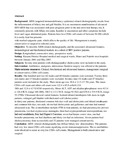Cholangiopathy in a Co-Hort of HIV Positive Kenyan Patients

View/
Date
2014Author
Otedo, A E O
Otieno, J O
Otieno, C F
Oyoo, G O
Language
enMetadata
Show full item recordAbstract
Background: AIDS (acquired immunodeficiency syndrome) related cholangiopathy results from the inflammation of biliary tree and gall bladder. It is an uncommon manifestation of advanced HIV/AIDS that was associated with poor prognosis prior to the anti-retroviral therapy era. It commonly presents with biliary tree pain. Jaundice is uncommon and other symptoms include fever and vague abdominal pains. Patients have low CD4+ cell counts of between 50-200 cells/ìl. It is rarely fatal but presents
with marked epigastric pain, which affects the quality of life. Management is mainly conservative or surgical in selected cases.
Objective: To describe AIDS-related cholangiopathy and the associated ultrasound features, immunological and biochemical markers in a cohort of HIV positive patients.
Design: Longitudinal, consecutive entry, prospective study.
Setting: Kisumu District Hospital medical and surgical wards, Mater and Nairobi west hospitals between January 2001 and May 2007.
Subjects: Seventy nine patients with cholangiopathy/ cholecystitis were included in the study.
Intervention: Antibiotics, analgesics, intravenous fluids/or surgery was offered to the patients.
Main outcome measures: Clinical, biochemical and ultrasound features, management (surgical or conservative), CD4+ cell counts.
Results: One hundred and two (42 males and 60 females) patients were screened. Twenty three (ten males and 13 females) patients were excluded. Seventy nine (32 males and 47 females) patients were included in the study. Their mean age was 38.8 ± 11.5 (17-70) years. The mean CD4+ cell count and white cell count were 122.4 ± 85.8 cells/ìl (3.0-
380) and 12.8 ± 4.5 X103/ìl respectively. Mean ALT, AST and alkaline phosphatase were 413.4 ± 126.4 IU/L (range 160-800), 340.5 ± 113.3 IU/L (range 92-562) and 678.8 ± 535.9 IU/L (range 55-2790). Ultrasound showed varied features: Isolated dilated intrahepatic bile ducts in eight patients, enlarged gall bladder with thickened wall (cholecystitis)
in thirty one patients, thickened common bile duct wall and cholecytitis and dilated intrahepatic and common bile duct, ten each, eleven had cholecystitis and gallstones and nine had normal ultrasound scan. The co-morbidities include; PTB in four patients, six had pneumocystis jiroveci pneumonia, two had cryptococcus meningitis, three had cryptosporidium/ microsporidium, ten had oral candidiasis, four had Kaposi’s Sarcoma, seven had herpes zoster virus, one had broncho-pneumonia, ten had diarrhoea and thirty two had no infections. Seven patients had cholecystectomy done successfully and 72 patients were managed conservatively.
Conclusion: AIDS- related cholangiopathy has diffuse biliary tree abnormalities. The patients had very low mean CD4+ cell counts signifying severe immunosuppression. The co-morbidities were observed to occur at very low CD4+ cell counts. Management is both conservative and surgical.
Publisher
University of Nairobi
Collections
- Faculty of Health Sciences (FHS) [10415]
